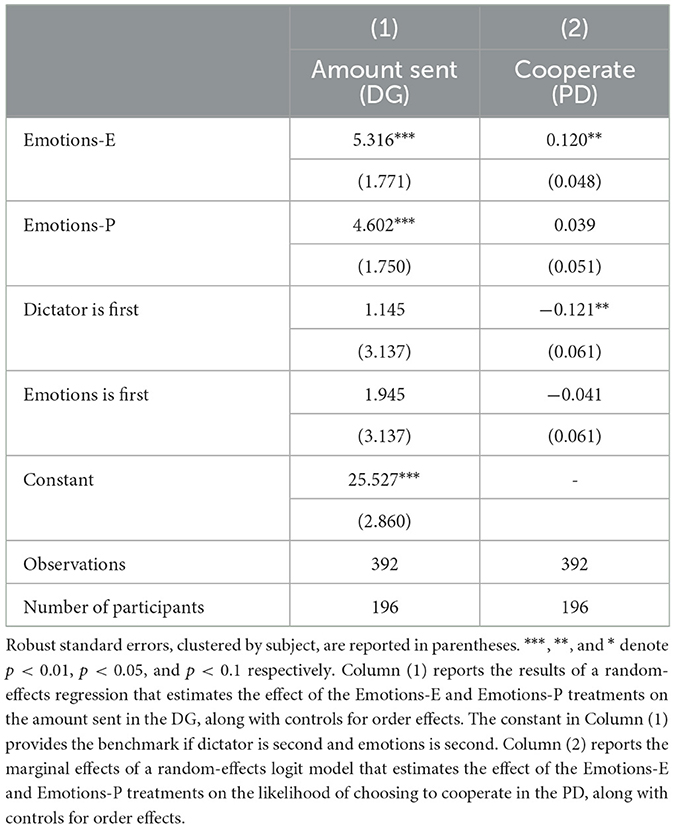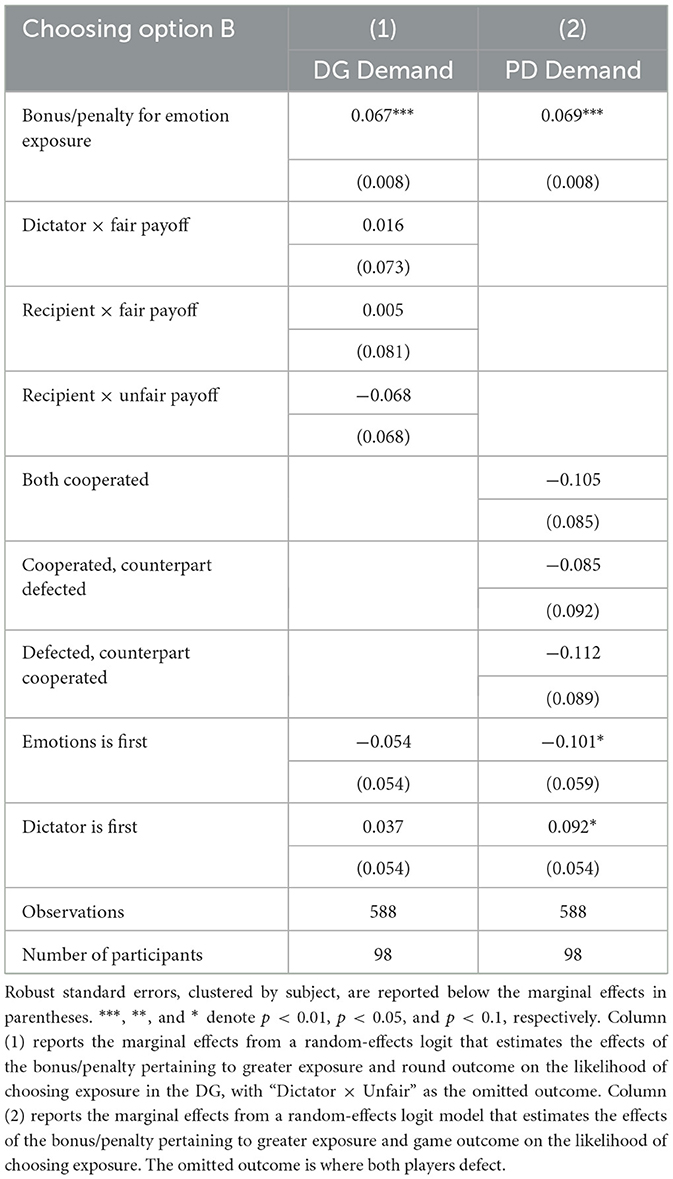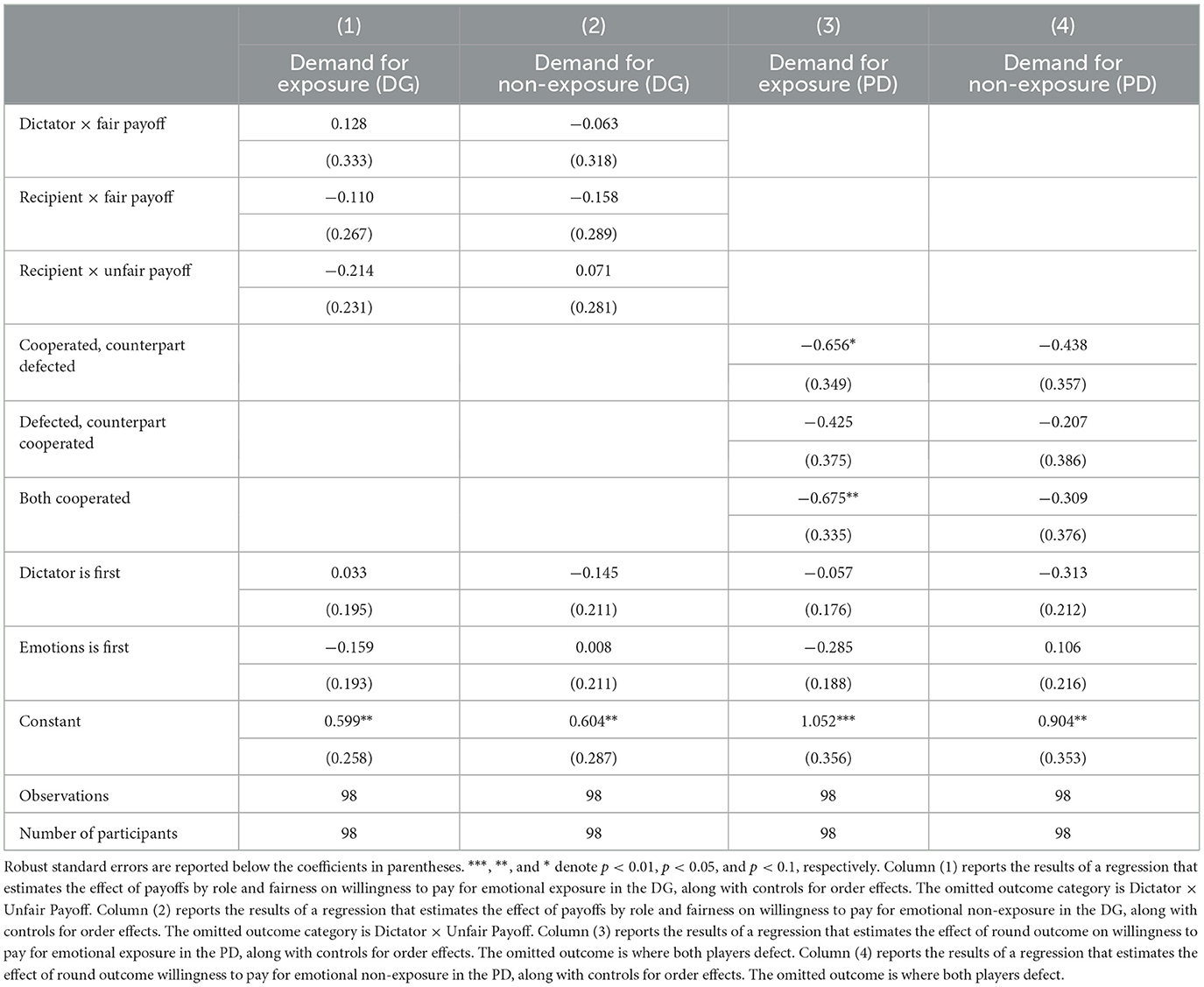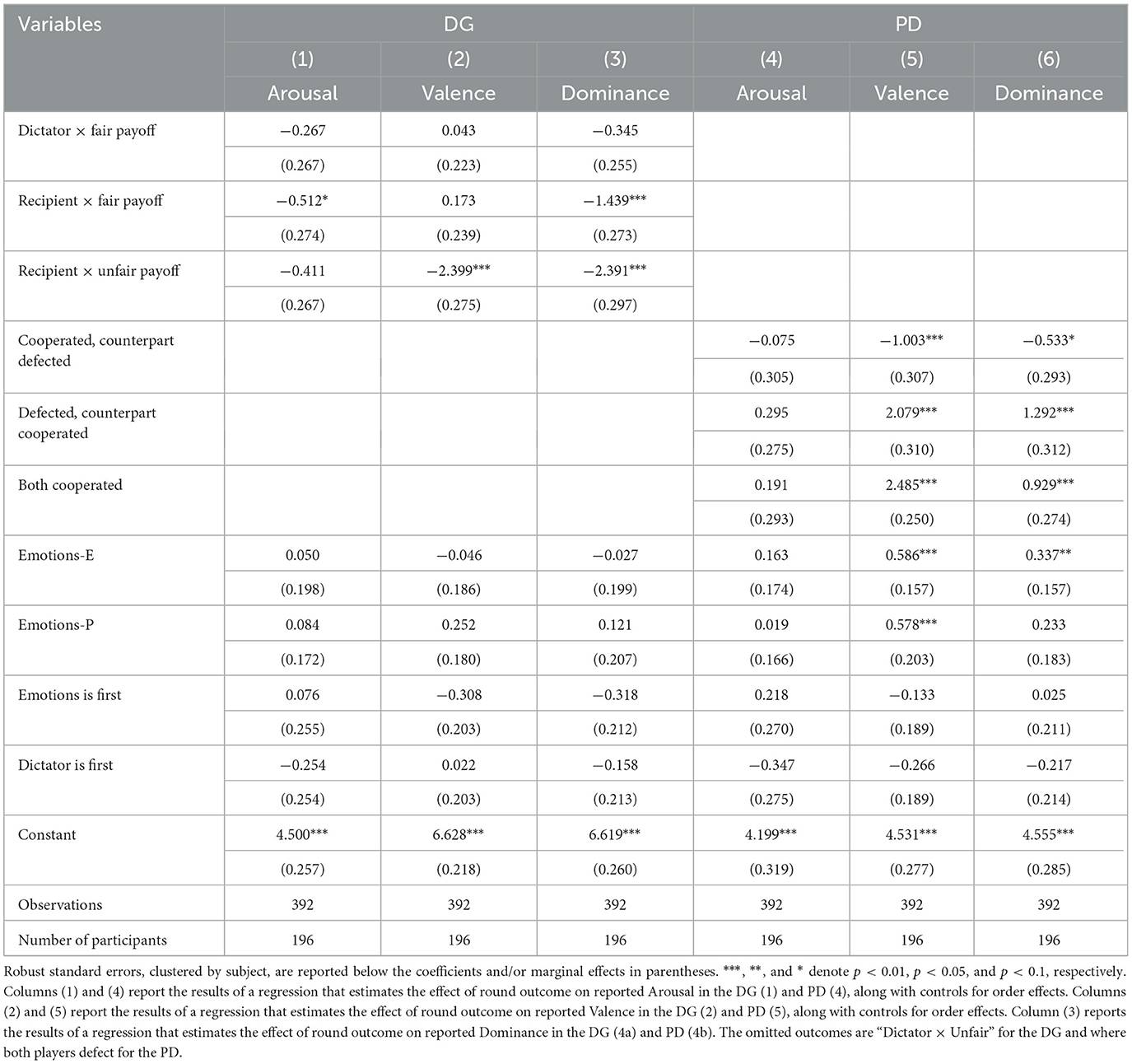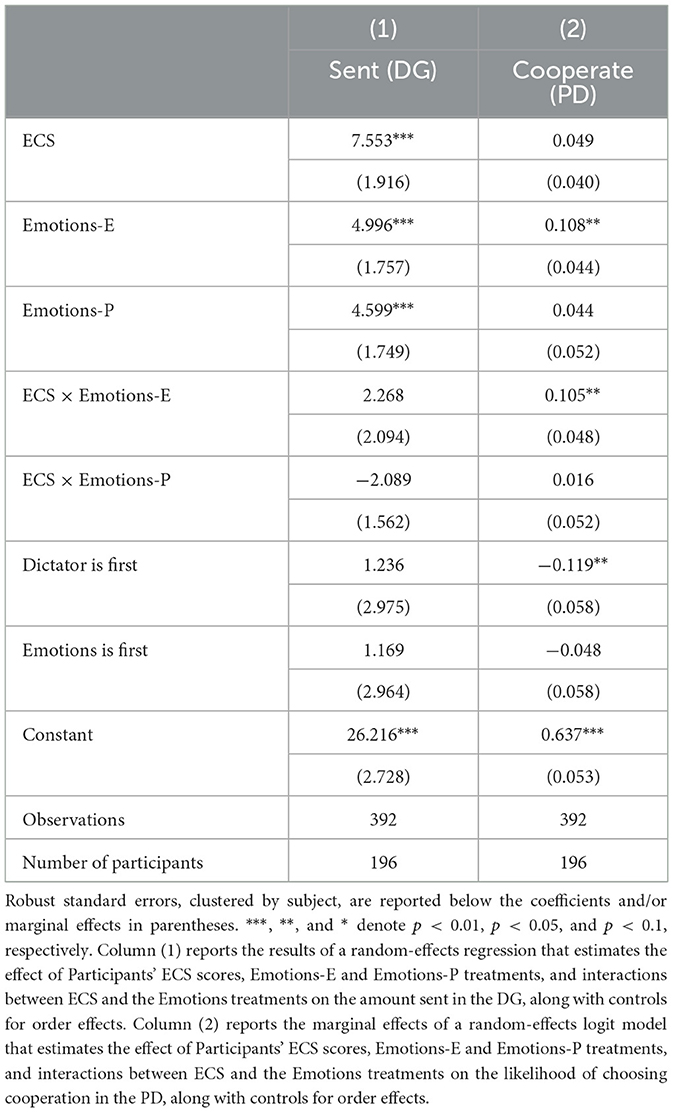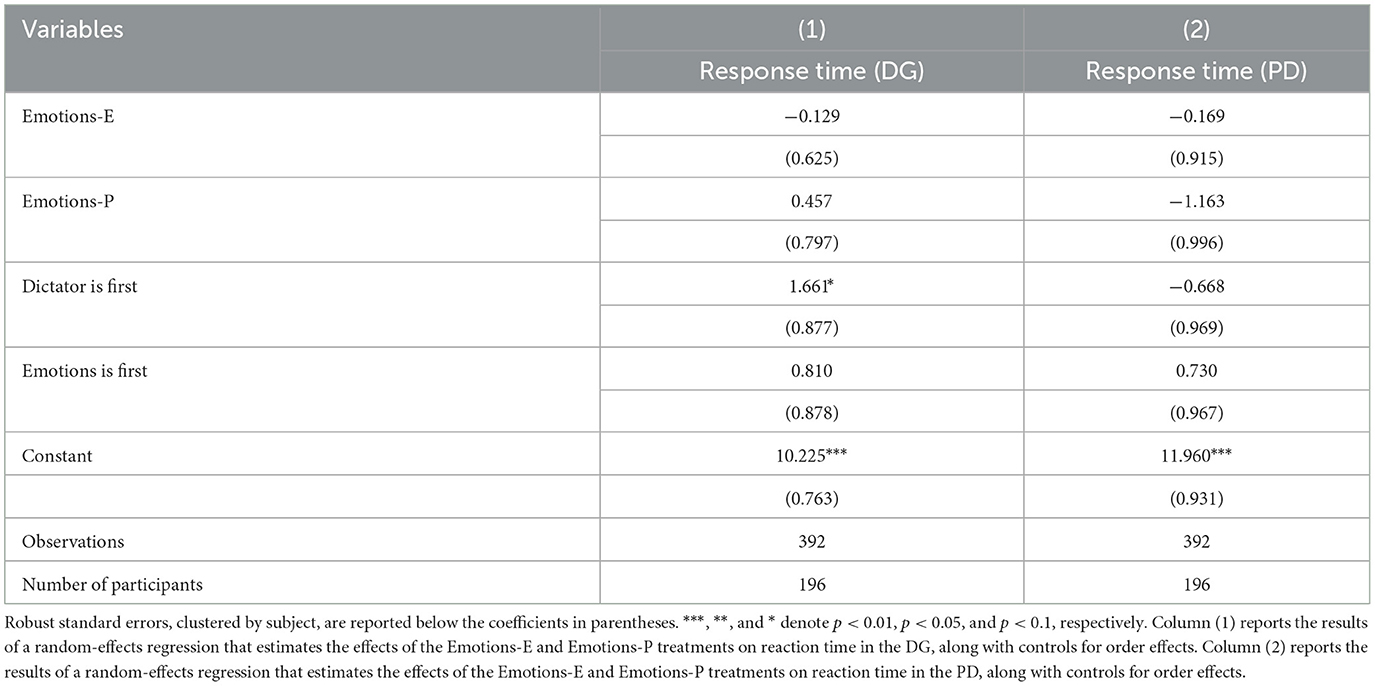- 1Behavioral Economics and Organizations Research Group, Macomb, IL, United States
- 2School of Accounting, Finance, Economics, and Decision Sciences, Western Illinois University, Macomb, IL, United States
- 3The Department of Management, Policy, and Community Health, School of Public Health, The University of Texas Health Science Center at Houston (UTHealth Houston), Houston, TX, United States
- 4School of Public and International Affairs, Princeton University, Princeton, NJ, United States
Social decisions with monetary consequences are often accompanied with emotional consequences. Previous studies document a robust role of pre-play message communication in facilitating pro-sociality and cooperation. Yet, the effects of communicating emotional experiences in social interactions (particularly post-play) remain understudied. Here, we examine the value of a social environment where emotional expressions are shared post-play in contrast to a private environment where emotion exposure is absent. We develop an experimental design that facilitates emotion exposure and can be readily administered in or outside the laboratory. In this pre-registered online study, participants (N = 196) completed incentivized extensions of the Dictator Game (DG) and the Prisoners' Dilemma Game (PD). Participants learned to classify their emotional experiences on the arousal, valence, and dominance dimensions using non-verbal pictorial representations. Our experiment comprised both a within-subject and a between-subject manipulation: each participant completed a control condition (C, no emotional exposure) as well as an emotion exposure condition (Emotions), but the type of exposure varied between subjects (certain exposure, or Emotions-E, or probabilistic exposure, or Emotions-P). In all conditions, participants complete a one-shot DG and PD. We find that emotion exposure increases other-regarding behavior under both Emotions-E and Emotion-P conditions in the DG and under Emotions-E only in PD. Further, we find that demand for emotion exposure is hardly driven by the outcome of the social interaction (or the actions selected). We also document how empathic concern influence other-regarding behavior and how reports of emotional experiences vary across treatments and with the different outcomes of social interactions. Our results highlight the integral role of emotion exposure in social decision making. Environments that facilitate the communication of emotional experiences increase pro-sociality and encourage cooperation.
1 Introduction
The results of economic interactions can often be accompanied with non-material (emotional) consequences. Previous studies document the robust role of communication (face-to-face discussion or written messages) before or when deciding whether to cooperate in social dilemmas (see Balliet, 2010 for a review). Communicating specific moment-to-moment felt emotions to counterparts' (e.g., joy at mutual cooperation) has been shown to increase the likelihood of cooperation in iterated prisoner's dilemma games (de Melo and Terada, 2020; Angelika-Nikita et al., 2022). A similar paradigm was implemented in the dictator game, where pre-play exposure to specific facial expressions (smiling face) increased pro-sociality (Scharlemann et al., 2001; Weiß et al., 2021). Nonetheless, facilitating emotion exposure in studies of social dilemmas or pro-social behavior remains very limited (particularly for post-play communication). Our study highlights the value of communicating emotional experiences in social contexts via an easy-to-administer experimental design.
Numerous studies suggest that pre-play communicated emotional experiences can play a vital role in social decisions. Participants' expectations of cooperation or non-cooperation affected their vicarious emotional responses in investment-style games (Lanzetta and Englis, 1989). There is also evidence that physical reactions to negative emotion (such as blushing) are tied to the perceived reliability of a partner in a Prisoners' Dilemma game (De Jong et al., 2002). Similarly, viewing an angry face increased the credibility of threats of rejection in the Ultimatum Game and lead to increased offers by proposers, though this effect disappeared when the threat was particularly strong (Reed et al., 2014). Additionally, smiling faces have been demonstrated to increase perceptions of the credibility of written statements (Reed et al., 2018). The effect of emotions on decision-making also extends to tasks involving person-based risk (Kugler et al., 2012).
Pre-play identification or communication also increased solidarity in dictator games and prisoners' dilemma games (Bohnet and Frey, 1999). This effect extended to increasing trusting and trustworthiness in a trust game (Ben-Ner et al., 2007), along with post-communication returns (Schniter and Sheremeta, 2014). The interaction between cheap talk and emotions has also been explored in a trust game: participants who broke promises reported higher levels of negative emotions (guilt and shame) than those who kept them, and trustees who returned more than the amount invested reported more positive emotions (pride and believability) than those who did not (Schniter and Sheremeta, 2014). Taken together, pre-play experienced emotion, and its communication, has been documented as an integral factor affecting social decision making.
Research on post-play communication of emotions, however, remains very limited. Contexts that facilitate exposure to verbal feedback (via written messages) increased pro-sociality in non-strategic settings (dictator game) (Ellingsen and Johannesson, 2008; Xiao and Houser, 2009) and had mixed effects in strategic settings (the ultimatum game) (Xiao and Houser, 2005, 2009). Further, free-form communication in the form of performance reviews for workers in a Gift-Exchange game increases both effort and efficiency (Du and Shahriar, 2018). These studies argue that the anticipated verbal feedback provides a medium for emotion exposure. In our study, we instead develop a platform (that can be easily administered in online experiments) for participants to directly communicate their emotional experiences (how they are feeling) after witnessing the outcome of the social interaction. An additional advantage of our methodology is that it can be used cross-culturally; participants communicate their emotions non-verbally rather than via free text communication.
2 Materials and methods
Our design, experimental code, hypotheses, and statistical methodology were preregistered on the Open Science Foundation's registry.1 We used Prolific to recruit our sample (N = 196). All participants complete two blocks of decisions with two games in each block: the Dictator Game and the Prisoners' Dilemma game. In the Dictator Game (DG), there are two players: the allocator and the recipient. The allocator decides how to split an amount of money (in our case, 100 points, where 1 point = $0.01) between herself and the recipient; the recipient is purely passive and receives whatever amount the allocator chooses to give her. We use the strategy method to capture choices in the Dictator Game, so both participants play as if they are the allocator (see Brandts and Charness, 2011 for a discussion on the general consistency of results across the strategy and the direct response methods). The allocator is then chosen by a random draw and their choice is used as the payment choice. Participants indicated their choice by inputting a number between 0 and 100 points into a numeric field.
In the Prisoner's Dilemma game (PD), players make a simultaneous choice between two strategies, “Cooperate” and “Defect” (framed in our experiment as “Action 1” and “Action 2”). If both players choose “Cooperate,” both players receive a payoff of 50 points. If both players choose “Defect,” both players receive a payoff of 10 points. If one player chooses “Defect” and the other chooses “Cooperate,” the defector earns 100 points and the cooperator earns 0 points. Therefore, both players have a dominant strategy to defect, which yields a Nash Equilibrium of {Defect, Defect} while the social optimum occurs at {Cooperate, Cooperate}. Participants made their choice by choosing between two radio buttons signifying the row strategies on a payoff matrix.2 We use the same conversion rate for the PD as the DG. We examine two widely-used games that study social behavior: the DG and the PD. Thus, we study altruism and the effect of anticipated emotional exposure in non-strategic contexts through the DG. We also study cooperative behavior and the effect of anticipated emotional exposure in strategic contexts through the PD. After completing each game, participants were matched with a counterpart and then shown the results (payoff for the game; in the case of the DG, they were also informed about their assigned role).
After viewing the results of the game, participants completed the Self-Assessment Manikin (hereafter, “SAM”; Bradley and Lang, 1994). This inventory measures emotional experiences on three different dimensions: arousal, valence, and dominance. Each dimension is measured using a 0–9 scale, where the numbers are represented by a set of 5 figures and 4 spaces in between figures. Figure 1A shows the SAM scale. The SAM scale has been validated cross-culturally and therefore provides a language-free methodology for participants to communicate their emotions (Morris, 1995).
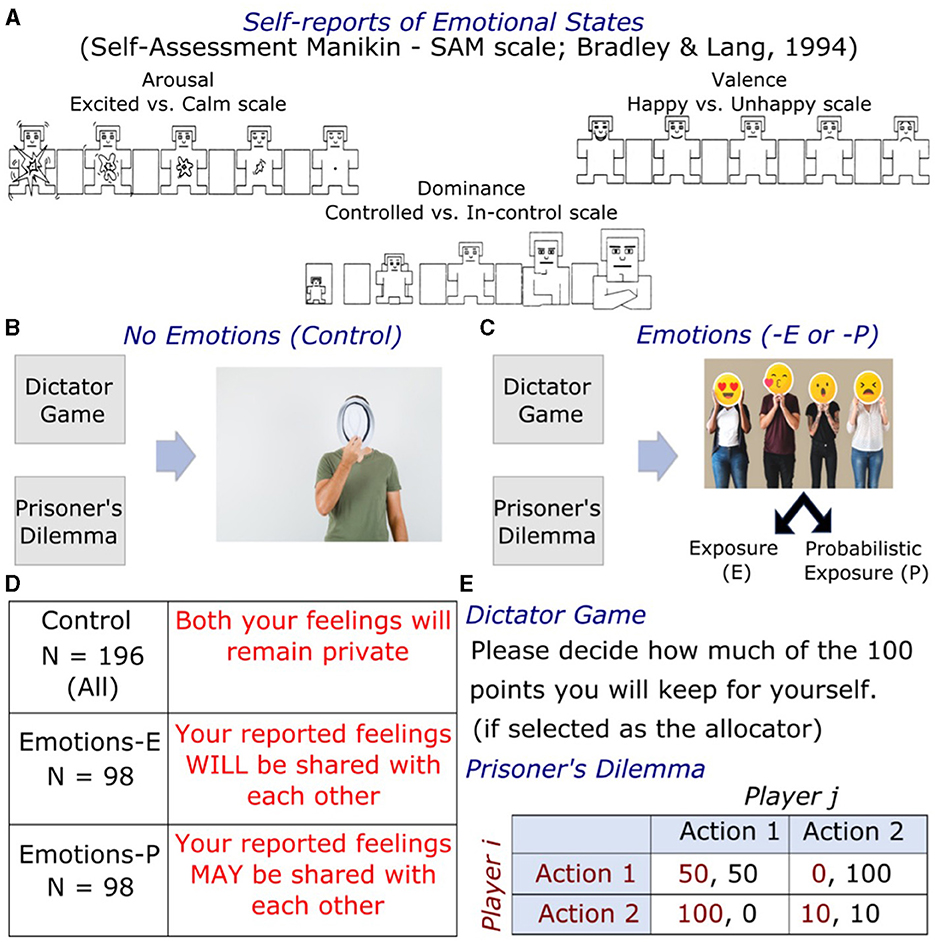
Figure 1. Experimental design. (A) The scales used to elicit emotional experiences (first at baseline then at the end of each task completed). All participants completed both tasks (Dictator Game–DG– and Prisoner's dilemma–PD) twice: once under the (B) no Emotions condition and once under the (C) emotions condition. Note that the images in (B, C) were embedded in the participants' instructions of each condition. The order of conditions and tasks were counter-balanced across sessions. Participants in the Emotions conditions were randomly assigned either to exposure with certainty–E or to probabilistic exposure–P; details for each condition are provided in (D). (E) Structure of the Dictator Game task and the Prisoner's Dilemma task (one-shot tasks). Attribution: Images in (B, C) are designed by rawpixel.com/Freepik.
2.1 Treatments and procedures
Participants complete the treatments in blocks, which are counter-balanced across experimental sessions to control for order effects (see Figures 1B, C). In “Emotions,” there was a positive chance that participants' emotional responses to the outcome of the games, reported using the SAM scale, would be revealed to their partner. This is divided into two sub-treatments, which are conducted between-participants: “Emotions Exposure;” “Emotions-E” condition hereafter and “Probabilistic Emotions Exposure;” “Emotions-P” condition hereafter. In Emotions-E, participants knew that their partner's emotions would be revealed with certainty. In Emotions-P, participants were informed that their partner's emotions may be revealed. In this condition, we further used a multiple price list methodology in which participants could receive a payoff in exchange for agreeing to a relatively higher or lower probability (90% or 10%) of being exposed to their partners' emotions. This methodology has the benefit of eliciting demand for either avoiding emotion exposure (10% chance of seeing counterpart's emotions) or revealing it (90% chance of seeing counterpart's emotions). In the “No Emotions” condition, which was completed by all participants, responses on the SAM task were not revealed to their partner. Participants in each session completed the games in the same order in each block; this allowed us to ensure that there are enough participants in a given game to be matched, which is essential to minimizing dropouts in an online setting on Prolific.
Participants provided informed consent before proceeding to the instructions.3 The instructions were presented in two parts. We first present an overview of the experimental procedures: participants were told that there were two parts to the experiment, Part A and Part B, and that they would play two games in each part. Participants were then introduced to the SAM scale, with an initial SAM task familiarizing them with it prior to describing either part of the experiment. Parts A and B involved either the “Emotions” (E or P) or the “No Emotions” blocks, with the order counterbalanced between sessions.
Participants then proceeded to the instructions for Part A, which included the instructions for the games and a statement of whether they will or may be exposed to their counterpart's emotions (and vice versa) or not (see Figure 1D), as well as a manipulation check question. Participants then began the first game, which was randomly ordered between sessions (see Figure 1E for the structure of both games). After participants made their choices, they were matched by arrival time with another participant and shown the results of their decisions.4 Next, they completed the SAM task. If Part A was the “Emotions-E” treatment, they were then shown their partner's responses to the SAM task. If they were in Emotions-P condition, exposure to the partner's emotional experience depended on their choices in the willingness to pay elicitation task (outlined below) as well as the random draw. In the control condition, they were merely shown the “Next” button to continue to the following task. Participants then completed the second game in the block with analogous procedures. After completing Part A, participants were shown the instructions for Part B and completed the two games again in the same order as Part A. If Part A was the “Emotions” treatment, participants completed the “No Emotions” treatment in Part B, and vice versa.
We used a multiple price list methodology to elicit individuals' demand for emotion exposure and/or avoidance in the Emotions-P condition. Figure 2 provides a screenshot of the task. Participants were asked to make seven choices between Option A (10% chance of exposure) and Option B (90% chance of exposure). Each choice other than choice 4 was associated with a positive payoff for either Option A (choices 1–3; trying to avoid information) or Option B (choices 5–7; trying to obtain information). If a participant chose Option A in the to-be-realized choice, they would have a 10% chance of seeing their partner's emotions and could also earn additional points in choices 1–3. Likewise, a participant who chose Option B in the to-be-realized choice would have a 90% chance of seeing their partner's emotions and could earn additional points in choices 5–7. Choice 4 does not involve a bonus to either option and gauges preference absent any incentivization. This methodology allows us to capture participants' willingness to pay for emotional exposure. For example, a participant who selects Option B in choices 3–7 gives up 3 points if Choice 3 is used to determine the likelihood of exposure to her counterpart's emotions; this means that we must compensate her with an amount that at least exceeds 3 points to switch her choice from Option B to Option A. In other words, this participant would be willing to pay up to 3 points to select Option B.
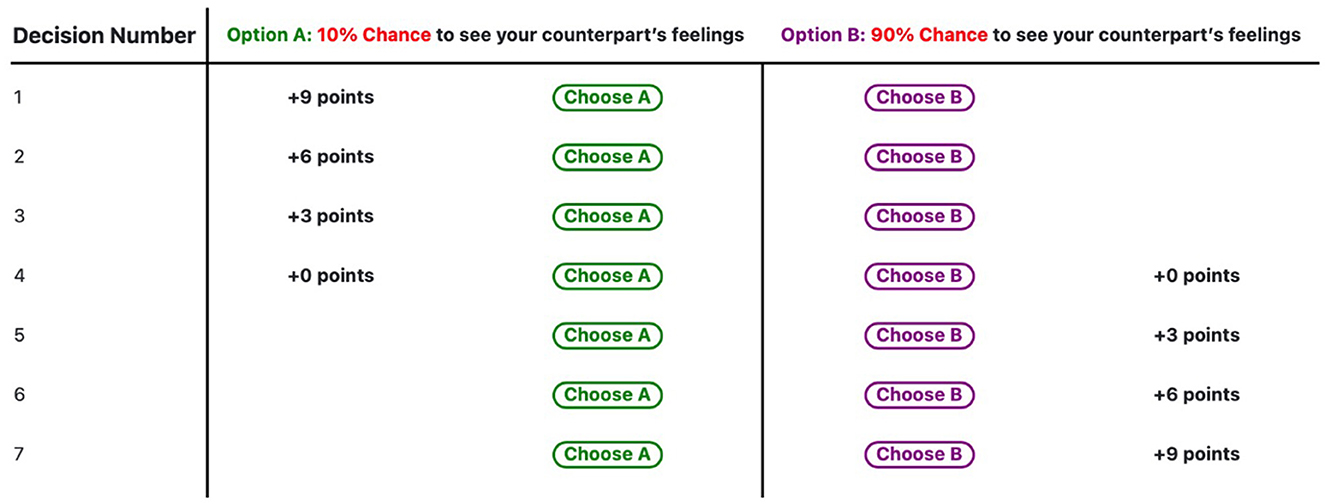
Figure 2. Demand for emotion exposure/avoidance. The Emotions-P condition involved a willingness-to-pay elicitation for emotion exposure/avoidance. Each participant completed the seven decisions with additional bonus payment (0–9 points) favoring either Option 1 (10% chance) or Option 2 (90%). Each decision could be realized, and a random draw determines the option that will be realized. These decisions were elicited once after the DG and a second time after the PD.
After completing parts A and B of the experiment, participants completed a brief survey that included the Empathic Concern Scale (hereafter, “ECS:” Batson et al., 1997), questions from the Global Preferences Survey (Falk et al., 2018, 2023), and demographic questions. The experiment was conducted on Prolific across 10 sessions between March 29 and March 31, 2023 and was coded in oTree (Chen et al., 2016). Participants were paid $3.50 as a completion fee; in addition, participants could earn up to an extra $1.09 based on one randomly-selected game (up to 100 points from the game plus up to 9 points from the Willingness-to-Pay task if the chosen game was in the Emotions-P condition) in one of the two conditions in which they participated. The average bonus payment was $0.50. The average completion time was 16 min and 25 seconds.
2.2 Sample size determination
We conducted an ex-ante power analysis (based on the meta-analysis of Balliet (2010), as outlined in our preregistration document) to determine our sample size. With power = 0.8 and alpha = 0.05, this power analysis estimated that 76 participants per condition were needed to detect the moderate effect size reported (Cohen's d of 0.46) of verbal/written communication relative to no communication (Balliet, 2010). Therefore, we determined that 200 participants would provide us sufficient power to test our preregistered hypotheses. Hence, we recruited a little over 200 participants in our experiment on Prolific. In all, we analyze data from 196 of 207 participants who were paid for participation.5 These participants completed the experiment in its entirety (i.e., were successfully matched in all tasks). The remaining 11 participants completed at least one task and were paid.6
2.3 Pre-registered hypotheses
Hypothesis 1a: Other-Regarding Behavior will be higher in the Emotions treatment than the Non-Emotions treatment in the Dictator Game.
Hypothesis 1b: Cooperative Behavior will be higher in the Emotions treatment than the Non-Emotions treatment in the Prisoners' Dilemma Game.
Hypothesis 2a: Willingness to pay to avoid information about a partner's emotions is decreasing in the amount sent to the recipient. Willingness to pay to see information about a partner's emotions is increasing in the amount sent to the recipient.
Hypothesis 2b: Willingness to pay to avoid information about a partner's emotions is decreasing in the level of self cooperative action taken. Willingness to pay to see information about a partner's emotions is increasing in level of self cooperative action taken.
In addition to these directional hypotheses, we also conducted three pre-registered analyses for which we made no directional predictions. First, we explored whether there is a difference in behavior between the Emotions-E and Emotions-P treatments. Second, we investigated the relationship between other-regarding/cooperative behavior and empathy using responses to the ECS questions. Third, we investigated the relationship between response time and other-regarding/cooperative behavior.
2.4 Deviations from the preregistration
We report one deviation from our preregistered hypotheses. After completing data collection, it became apparent that our preregistered statistical tests of Hypothesis 2 A-B involve only the action taken by a participant and not the outcome of the game. However, participants saw the outcome of the game prior to their demand for emotional exposure being elicited. Therefore, the specifications reported in the main text of the paper focus on the effect of the game outcome; we report the results of the original, preregistered specification in Appendix Table A2. Both analyses do not support hypothesis 2.
3 Results
We begin our analysis with an exploratory manipulation check.7 Before beginning each of the two experimental parts, we asked participants: “Please indicate the extent by which you agree with the following statement, using a scale from 0–10 where 0 represents not likely at all and 10 represents very likely. In this part of the study, I will be informed of my partner's reported feelings.” As shown in Figure 3, most participants in the Control treatment−80% of those who completed Control and Emotions-E, 75% of those who completed Control and Emotions-P—indicated that they disagreed completely with this statement. In Emotions-E, approximately 80% of participants indicated they agreed completely with the statement. On the other hand, the majority of participants in Emotions-P indicated at least partial agreement with the statement (5 on the scale or greater). This provides strong evidence that our manipulations were successful in shifting beliefs about the likelihood of emotions exposure.
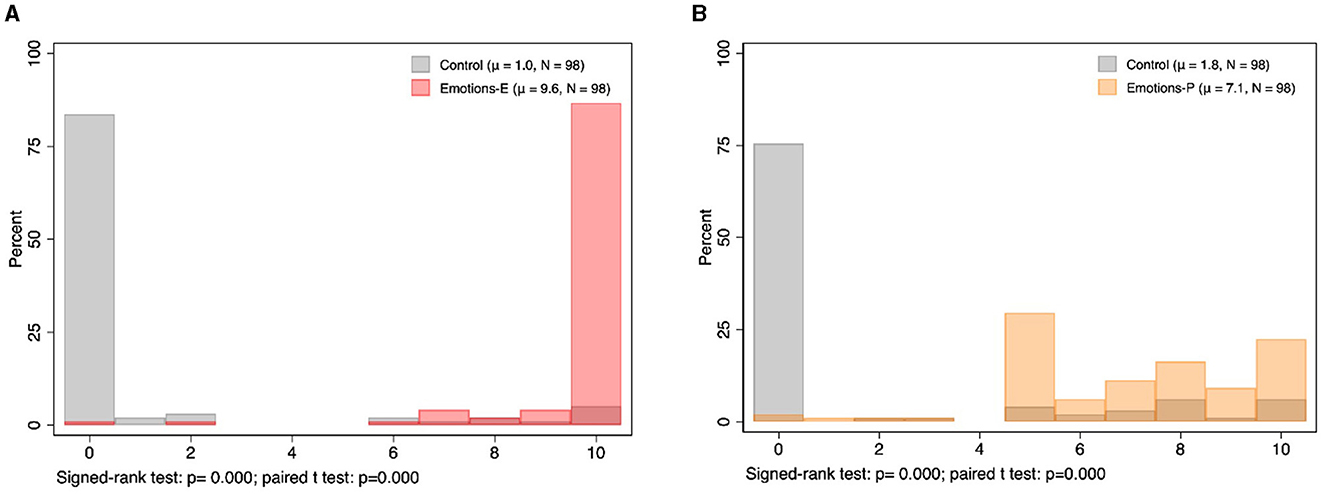
Figure 3. Responses to manipulation check question by treatment conditions. Within-Participants tests highlight that the perceived likelihood of emotion exposure was higher under (A) Emotions-E or (B) Emotions-P conditions. Between-Participants test provide evidence that beliefs about the likelihood of emotion exposure was higher under Emotions-E, relative to Emotions-P (Rank-sum test, N = 196: p < 0.01; baseline conditions did not vary across groups, p > 0.10).
We next investigate whether our treatments affected other-regarding behavior in both the non-strategic Dictator Game (DG) and the strategic Prisoners' Dilemma Game (PD). As shown in Figure 4, the Emotions conditions significantly increased the sent amount in the DG (Means: Emotions-E: 30.7; Emotions-P: 33.3; Control: 24.7; and 29.4 for Emotions-E and Emotions-P, respectively; Wilcoxon Signed-Rank Tests: p = 0.002, N = 98 for Emotions-E vs. Control and p = 0.063, N = 98 for Emotions-P vs. Control; Paired t-tests: p = 0.001, N = 98 for Emotions-E vs. Control and p = 0.039, N = 98 for Emotions-P vs. Control). Thus, as is demonstrated in Figures 4A–D, the amount sent was greater in the Emotions conditions, particularly for Emotions-E as results from both parametric and non-parametric tests (Paired t-test and Signed-Rank test, respectively) are statistically significant (only the former is significant for Emotions-P). We find analogous result for the frequency of cooperation in the PD as shown in Figures 4E–H (Means: Emotions-E: 0.663; Emotions-P: 0.592; Control: 0.551 for both the control samples for Emotions-E and Emotions-P; McNemar's Exact Test: p = 0.035, N = 98 for Emotions-E vs. Control and p = 0.585, N = 98 for Emotions-P vs. Control).8 As shown in Figure 4G, 75 participants made the same choice in Emotions-E and control conditions. Of the remaining 23 participants who made opposing choices, the majority, 74% (17 out of 23 participants), cooperated in the Emotions-E condition but defected in the Control condition. This indicates a substantial “pull” toward cooperation in the Emotions-E condition (as is confirmed by the McNemar's Exact test). On the other hand, Figure 4H shows that 68 participants made the same choice in Emotions-P and control conditions. Of the remaining 30 participants who made opposing choices, only 57% (17 out of 30 participants) cooperated in Emotions-P but defected in the Control condition. Thus, the “pull” toward cooperation in Emotions-P condition was weaker and not statistically significant.
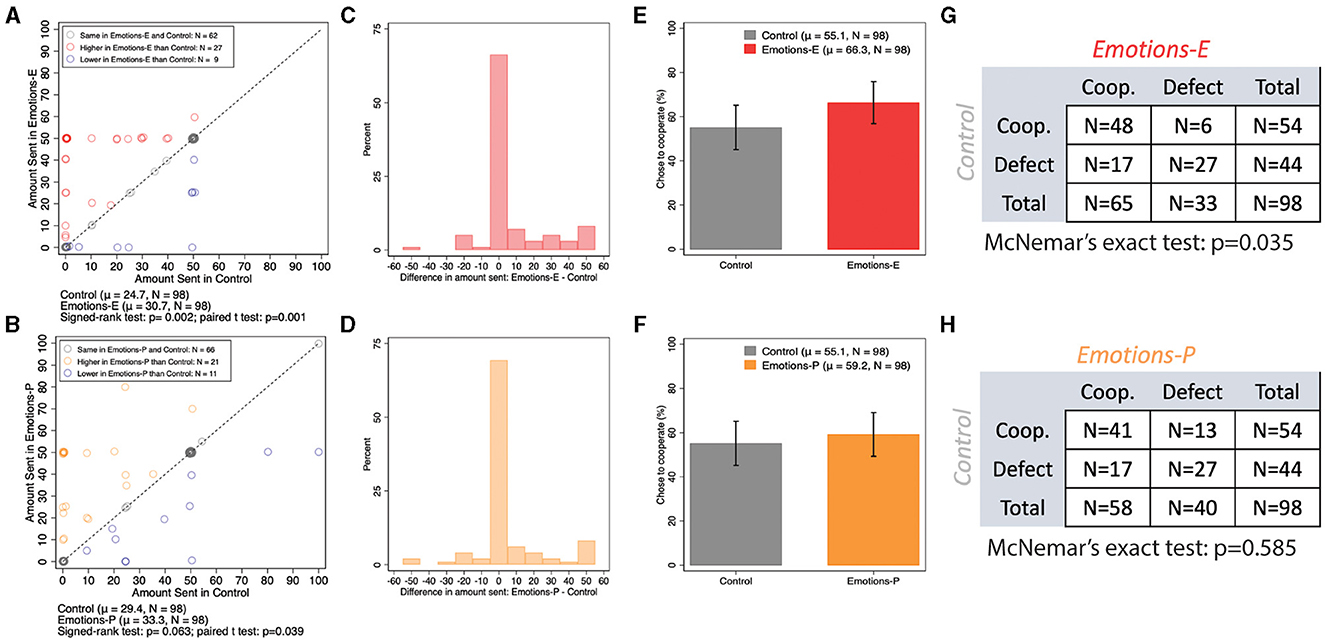
Figure 4. Other-regarding behavior by treatment conditions. Amount sent by dictator to counterpart in each condition for participants completing (A) Emotions-E and control conditions or (B) Emotions-P and control conditions. Dashed lines display 45-degree reference. Points are jittered minimally for visualization purposes. Distributions for the difference in amount sent between (C) Emotions-E and control conditions and (D) Emotions-P and control conditions. Results from paired t-test and signed-rank test are reported. Frequency of cooperation in the Prisoner's Dilemma game for participants completing (E) Emotions-E and control conditions or (F) Emotions-P and control conditions. Line bounds show 95% confidence intervals. Contingency tables summarizing Prisoner's dilemma cooperation/defection in each condition for participants completing (G) Emotions-E and control conditions or (H) Emotions-P and control conditions. Results from McNemar's exact test are reported; the test is appropriate for binary repeated measurements and probes for differences in proportions for the discordant cells.
We use a random-effects regression model for the DG and a random-effects logit model for the PD to identify the treatment effects parametrically while controlling for order effects using indicator variables for participants who saw the dictator game first (“Dictator First”) and for participants who saw the Emotions (E or P) condition first. The results (coefficients for DG, marginal effects for PD) are provided in Table 1. The Control treatment serves as our reference treatment. These results mostly echo the results of our preregistered hypotheses (1A-B).9 For the dictator game, both Emotions-P and Emotions-E have a strong positive effect—the treatments increase the amount sent by just over 5 points in Emotions-E and just under 5 points in Emotions-P for the DG. For the PD, the Emotions-E treatment increases the likelihood of cooperation by 12%; however, there is no statistically significant effect from Emotions-P.10 This gives our first result:
Result 1: Emotion exposure increases other-regarding behavior under both certain and probabilistic emotions exposure in DG and under certain emotions exposure only in PD.
We also investigated whether the estimated coefficients of the Emotions-E were significantly different from Emotions-P, in accordance with our preregistered analysis. Post-estimation χ2 tests of the coefficients for Emotions-E and Emotions-P indicate that the effects are not significantly different for either DG or PD (DG: p = 0.817, PD: p = 0.234).11
We next examine whether participants' actions affect their demand for emotional exposure in Emotions-P (Hypothesis 2). We first conduct an exploratory analysis to check the validity of the instrument. Figure 5 shows the percentage of participants choosing exposure (Option B) by each gamble in the demand elicitation task. For both the DG and PD, participants respond strongly to incentives, with most participants choosing the option that yields a positive payoff in each gamble. Interestingly, the frequency of choosing Option A was close to that of choosing Option B in decision 4, which had a payoff of 0 for choosing either option.
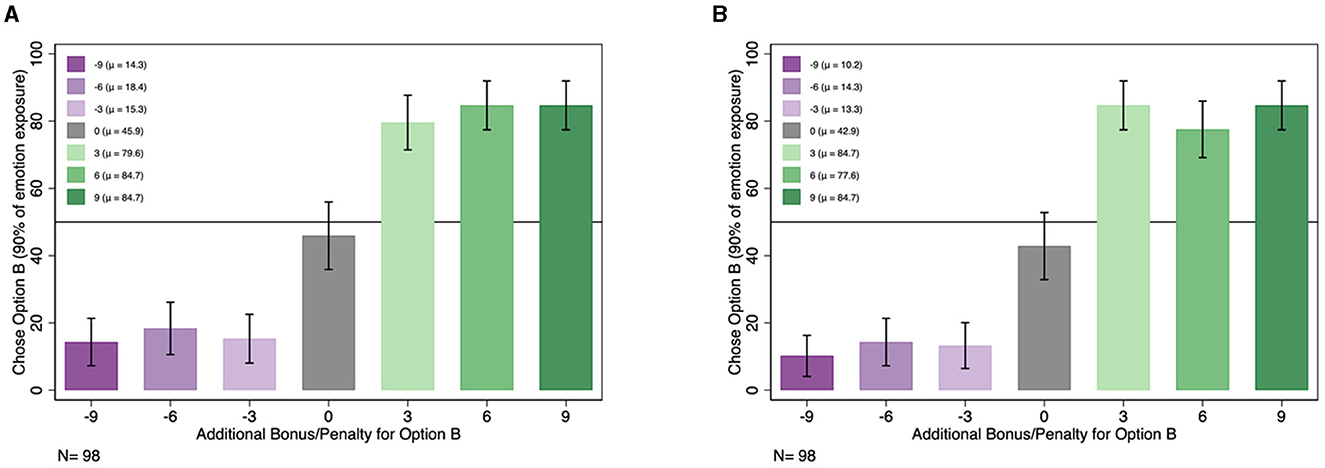
Figure 5. Demand for emotion exposure/avoidance in each decision. The frequency of choosing Option B for each of the 7 demand elicitation questions (see Figure 2). (A) Reports these statistics for the DG, while (B) reports these statistics for the PD. Error bars denote 95% Confidence intervals.
Table 2 reports the marginal effects of a random-effects logit model with an indicator dependent variable for whether the subject chose Option B with the additional bonus/penalty paid to (incurred by) participants for choosing exposure as an independent variable. In addition, we control for the outcome of the game. In all cases, the primary driver of the likelihood that a participant chooses B appears to be the price paid for exposure, which is positively and significantly related to the likelihood of choosing exposure. The outcome of either the DG or the PD did not affect the likelihood of choosing Option B. This provides initial evidence against our second pre-registered hypothesis, which is further examined next.
To test H2, we derive two measurements: (1) exposure demand and (2) for non-exposure demand. Demand is measured by the number of times the participant chooses Option B when the payoff from doing so is negative (Demand for Non-Exposure) and when the payoff from doing so is positive (Demand for Exposure).12 We omit Decision 4 from our analyses, as the participant earned no incentive from selecting either option in this scenario; however, we consider it in our specifications in Appendix B.
For each game, we regress these demand measures over the outcome of the game and controls for order effects (Table 3). In the DG, we explore the effect of three possible outcomes. In the first case (Dictator × Fair Payoff), the player is the dictator who also chose an allocation that involves sending exactly half of the amount to be split-−50 points (thus, earning a fair payoff equal to the recipient). In the second case (Recipient × Fair Payoff), the player is the recipient who received a fair payoff (again, equal to the dictator). In the third case (Dictator × Unfair Payoff), the player is the dictator who chose an allocation that involved an uneven split (in favor of either the dictator or the recipient). The final case (Recipient × Unfair Payoff) involves the player as the recipient who received an unfair payoff. We construct a similar set of measures for the PD game, categorized by the strategies chosen by both players. “Both Cooperate,” for example, is the case where both the player and her counterpart chose the cooperative strategy (see Figure 1E). In the fitted regressions, the omitted category was Dictator × Unfair Payoff for DG and Both Defect for the PD. As shown in Table 3, the outcome of the game does not affect demand for exposure or non-exposure in the DG. In the PD, participants who cooperated were instead somewhat less likely to pay for exposure (regardless of whether their counterpart chose “Cooperate” or “Defect,” with the latter being only marginally significant). This suggests that choosing the cooperative action, rather than the outcome of the game, dampen the demand for emotion exposure (only marginally as shown in Appendix Table A2). Yet, this relationship suggests that other-regarding behavior does not seem to increase demand for emotion exposure. Moreover, we find no effect of game outcome on demand for non-exposure in the PD. On the other hand, neither the amount sent (see Appendix Table A2) nor the round outcome appears to affect willingness to pay for either exposure or non-exposure in the DG.
Result 2a: There is no statistically significant relationship between outcomes in the dictator game (or amount sent) and willingness to pay for exposure or non-exposure.
Result 2b: Participants who choose the cooperative strategy in the Prisoner's Dilemma are not more willing (less willing) to pay for emotion exposure (non-exposure). 13
An important next step is to examine how the outcome of each game affects participants' self-reported emotional experiences, alongside any treatment differences. Figure 6 provides a snapshot of how the outcome of the games affect reported emotions. Furthermore, we conduct an exploratory analysis of each of the three dimensions (arousal, valence, and dominance) reported after both the DG and the PD using a random-effects regression model that controls for treatment and game outcome. The results are provided in Table 4. For the DG, recipients who received an unfair payoff reported more negative valence levels (relative to the reference category: dictators with an unfair payoff). Moreover, recipients, regardless of their payoff, reported lower dominance levels. Neither Emotions treatments significantly affect the reported emotions in the DG. In the PD, participants who cooperated but were defected on reported more negative valence and marginally lower dominance levels (relative to the reference category: both players defected). On the other hand, more positive valence and dominance levels were reported by (1) participants who cooperated while their counterparts also cooperated and (2) participants who defected while their counterparts cooperated (thus, in situations where they earned the maximum payoff given their strategy). Additionally, both the Emotions-P and Emotions-E treatments increase reported valence relative to the Control treatment, and those in the Emotions-E treatment also report increased dominance relative to the Control treatment.14
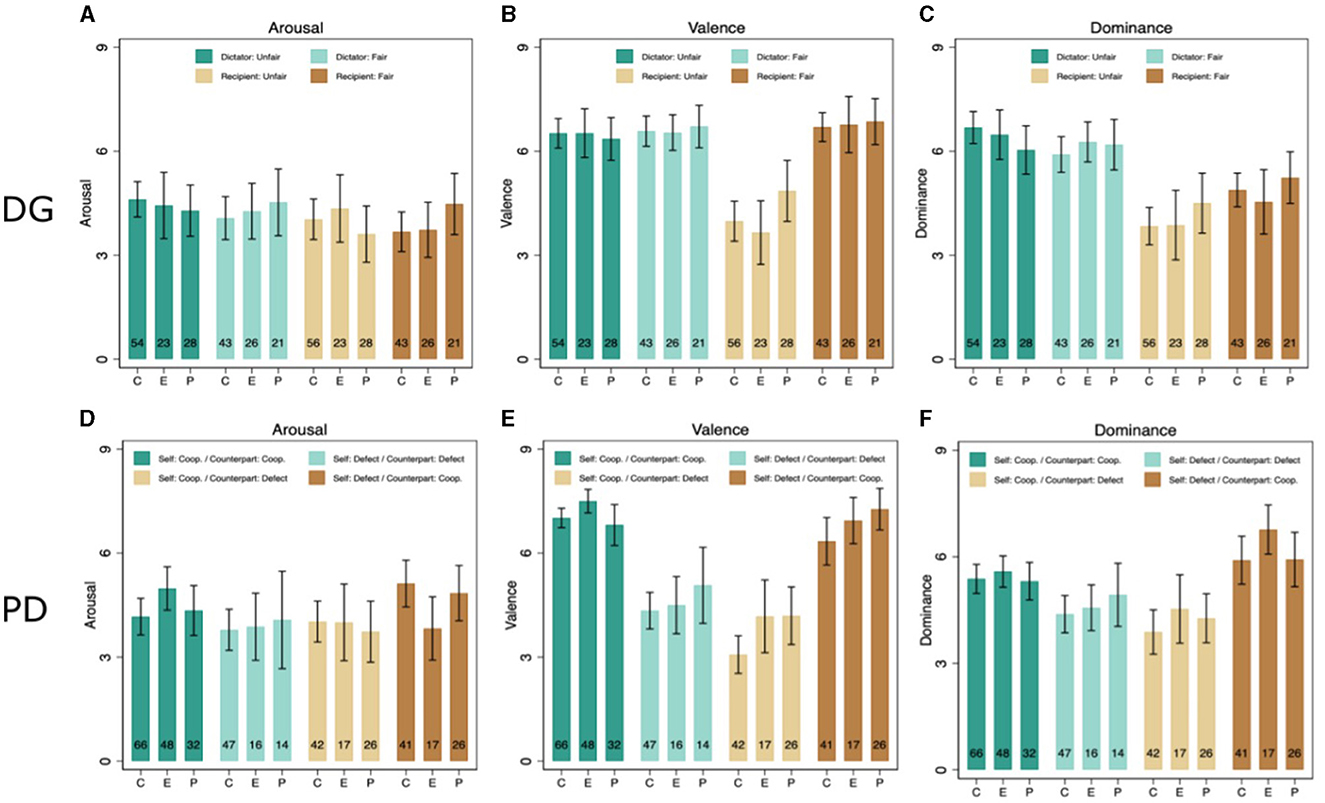
Figure 6. Self-reported emotional experiences and the outcome of social interaction. Average self-reported emotions (via the SAM scales) reported by each outcome of the DG game (A–C) and for the PD game (D–F). In each panel, “C,” “E,” and “P” denote the Control, Emotions-E, and Emotions-P treatments, respectively. Error bars denote 95% confidence intervals.
Result 3a: In the DG, recipients' reported lower dominance levels than dictators regardless of outcome; recipients who receive an unfair payoff also reported lower valence level.
Result 3b: In the PD, those who cooperated but their counterpart defected reported lower valence; those who earned the maximum payoff given their chosen action (cooperate or defect) reported more positive valence and greater dominance; those in Emotions-E and Emotions-P reported more positive valence, and those in Emotions-E also report higher dominance.
We next investigate whether empathy, measured by the Empathic Concern Scale, is primed by our Emotions treatments (pre-registered exploratory analysis). We estimate a random-effects model, mimicking (Table 1), with the participant's behavior (DG: Amount Sent, PD: Choosing Cooperate) as the dependent variable, and the following as independent variables: the participant's composite ECS score, treatment indicators, interactions between ECS score and treatment indicators, and controls for order effects (output reported in Table 5).
Participants' ECS score does not amplify or attenuate the treatment effects of Emotions-P or Emotions-E in the DG; however, it is positively correlated with the amount sent. For the PD, ECS does not affect propensity to choose to cooperate in the Control treatment or in the Emotions-P treatment; however, participants with higher empathic concern are significantly more likely to choose to cooperate in Emotions-E. This suggests that ECS may increase cooperative behavior in the PD when the environment involves certain emotion exposure only.
Result 4a: Empathic concern is positively correlated with the amount sent in the DG, but does not modulate the effects of the Emotions treatments relative to the control treatment.
Result 4b: Empathic concern seems to further amplify the Emotions-E treatment effect on the likelihood of choosing to cooperate in the PD.
Note that the main treatment effects for Emotions-E (or -P) in the DG and Emotions-E in the PD remained significant after controlling for the ECS. This implies that these treatment effects were not driven by participants who were more empathetic only. In the PD, we do find an additional interactive effect for the Emotions-E treatment; it remains unclear (and an area for future study) whether this is because high-empathy participants feel more guilty at choosing defect when being exposed to their counterparts' emotional responses, or whether this is in anticipation of strategic reporting of emotions by one's counterpart.
Finally, we investigate whether response time varied by treatment (pre-registered exploratory analysis). Figure 7 provides histograms of response time by treatment for each game. We also investigate this further using a random-effects model similar to the specification in Table 1, with response time as the dependent variables while controlling for the same set of independent variables (output reported in Table 6).
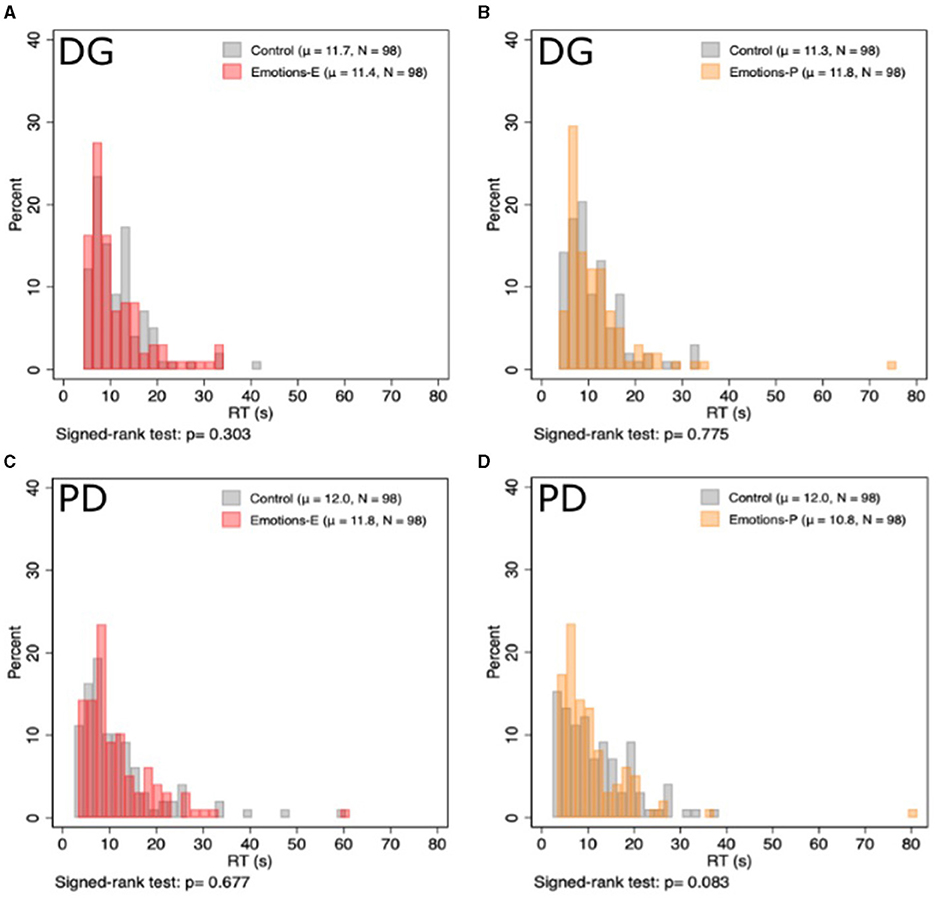
Figure 7. Response time by treatment conditions. Distribution of reaction time for the Dictator Game (DG) for (A) the control condition and Emotions-E condition or (B) the control condition and Emotions-P condition. Distribution of reaction time for the Prisoner's Dilemma Game (PD) for (C) the control condition and Emotions-E condition or (D) the control condition and Emotions-P condition.
Consistent with results from Figure 7, Table 6 demonstrate that there is no significant effect of the Emotions treatments on response time for either the DG or the PD. Importantly, this can be taken as suggestive evidence that participants do not seem to exert additional cognitive effort in the emotion conditions relative to the control condition. An interesting area for future research is whether the null effect of the emotions treatment extend to other choice process data such as attention (gaze fixation or saccades).
Result 5: There is no significant effect of emotional exposure on participants' response time in the PD or DG.
4 Discussion
Anticipated emotions can play an important role in shaping economic behavior (Schlösser et al., 2013; Dunning et al., 2017). We investigate whether post-play emotion exposure (access to information about one's counterpart's feelings after social interactions) causes less selfish behavior in the Dictator Game and more cooperation behavior in the Prisoner's Dilemma game. It has been posited that emotions can serve as a signaling system in social dilemmas (Ross and Dumouchel, 2001). Thus, environments that facilitate emotion exposure (knowing how one's actions affect another person's emotional state) may alter behavior relative to contexts that mask such information. In this study, we demonstrate that mere anticipation of exposure to other's emotions changes social behavior in both strategic and non-strategic contexts (since emotions could have been revealed only post-play). Particularly, our results highlight that anticipated exposure to one's partner's emotions increases generosity in the Dictator Game and makes participants more likely to pursue the cooperative strategy in the Prisoner's Dilemma Game. Additionally, there is a positive relationship between participants' empathy level and other-regarding behavior in both games (either as a main effect or through its interaction with our emotion exposure condition). This implies that both interpersonal displays of emotion and individuals' homegrown empathy are integral to other-regarding behavior. In other words, studying social decision making without facilitating emotion exposure may result in biased inference. This finding is particularly important given recent evidence demonstrating poor external validity of standard social preference experimental games (Galizzi and Navarro-Martinez, 2019).
Our contribution to the literature is 2-fold. Our first major contribution is a methodological one. We develop an experimental design that facilitates emotion exposure and can be readily administered in or outside the laboratory. We implement a medium of communication of emotions that abstracts away from free text communication; thus, it readily extends for cross-cultural studies. Our manipulation checks reveal that the design is successful in shifting participants' beliefs about the extent of emotion exposure. We demonstrate the substantial treatment effects of emotion exposure in both strategic and non-strategic contexts. We elicit demand for emotion exposure and find that it is hardly driven by the outcome of the social interaction (or the actions selected). In other words, greater pro-social behavior (i.e., increased transfer in the DG) when anticipating emotion exposure does not seem to be driven by a simple preference to avoid negative (emotional) feedback. We also demonstrate the differential reports of emotional experiences across the different outcomes of social interactions in strategic and non-strategic contexts (see Table 4). Moreover, the emotion treatments do not result in different response time distributions (potentially suggesting that no additional exertion of cognitive effort was required under the emotion exposure conditions).
Our second contribution is that we, to our best knowledge, provide the first exploration of within-participants post-play communication of emotional experience in one-shot setting while also eliciting willingness to pay for emotion exposure. Prior work investigated how communication affects social behavior, yet this work either focused on pre-play communication (e.g., De Jong et al., 2002; Reed et al., 2014, 2018) or on verbal communication (Ellingsen and Johannesson, 2008; Xiao and Houser, 2009). Pre-play (or during-play) knowledge of one's counterpart's emotions has been demonstrated to increase cooperation in the prisoners' dilemma game (de Melo and Terada, 2020; Angelika-Nikita et al., 2022). Similarly, pre-play identification increased offers in the dictator game (Bohnet and Frey, 1999). Post-play verbal communication was also shown to facilitate other-regarding behavior (Ellingsen and Johannesson, 2008; Xiao and Houser, 2009; Torsvik et al., 2011). Our findings are largely in line with the extant literature. However, we examine how an environment that facilitates post-play communication of emotional experiences (arousal, valence, and dominance) using non-verbal pictorial representations (Bradley and Lang, 1994) affect social behavior in strategic and non-strategic settings. We find that post-play communication of emotions increases the amount sent in the DG and the likelihood of cooperation in the PD when emotional exposure is certain (Emotions-E); further, probabilistic emotions exposure (Emotions-P) also increases the amount sent in the DG (non-parametric tests provide only marginal support for this finding; see Figure 4 and Table 1).
Future extensions of this study's paradigm would aim to identify the mechanism by which emotion exposure in experimental games alter social preferences. Do these treatments, which enhance other-regarding behavior, activate an inherent preference for social regulation of emotion (Reeck et al., 2016), do they attenuate the effects of cognitive dissonance (Konow, 2000), or do they amplify the extent of guilt aversion (Baumeister et al., 1994)? Another important area for future study involves expanding the sample size to facilitate the identification of heterogeneous effects of emotion exposure, and the underlying mechanism, across groups (e.g., age, gender). Finally, the examination of how the choice process of decision making itself changes in environments that incorporate emotion exposure (for example, via eye tracking or through psychophysiological measurements) can be integral in understanding the mechanism by which emotion exposure influence social behavior.
Data availability statement
The data and source code are available on Open Science Framework at https://osf.io/8bfzx.
Ethics statement
The studies involving humans were approved by the Institutional Review Board of Princeton University. The studies were conducted in accordance with the local legislation and institutional requirements. The participants provided their informed consent to participate in this study.
Author contributions
JBG: Conceptualization, Data curation, Formal analysis, Investigation, Methodology, Project administration, Software, Validation, Visualization, Writing–original draft, Writing–review & editing. AA: Conceptualization, Funding acquisition, Resources, Data curation, Formal analysis, Investigation, Methodology, Project administration, Software, Validation, Visualization, Writing–original draft, Writing–review & editing.
Funding
The author(s) declare that financial support was received for the research, authorship, and/or publication of this article. Funding provided by the Department of Management, Policy, and Community Health in the School of Public Health at the University of Texas Health Science Center at Houston (UTHealth Houston) and the School of Public and International Affairs at Princeton University.
Conflict of interest
The authors declare that the research was conducted in the absence of any commercial or financial relationships that could be construed as a potential conflict of interest.
Publisher's note
All claims expressed in this article are solely those of the authors and do not necessarily represent those of their affiliated organizations, or those of the publisher, the editors and the reviewers. Any product that may be evaluated in this article, or claim that may be made by its manufacturer, is not guaranteed or endorsed by the publisher.
Supplementary material
The Supplementary Material for this article can be found online at: https://www.frontiersin.org/articles/10.3389/frbhe.2024.1304833/full#supplementary-material
Footnotes
1. ^The preregistration and oTree code can be accessed at: https://osf.io/p2nes; the data and analysis files can be accessed at: https://osf.io/8bfzx.
2. ^We used a symmetric prisoners' dilemma, enabling us to allow both participants to choose as the row player.
3. ^All procedures and experimental materials were approved by the Internal Review Board (IRB) at Princeton University.
4. ^From the perspective of the participants, this should be similar to random re-matching between rounds; however, group by arrival time is recommended for online experiments to minimize dropouts (for an example, see: https://otree.readthedocs.io/en/latest/multiplayer/waitpages.html).
5. ^We did not analyze data from another 15 participants who left the experiment early and did not complete it (“returned their task”) since these participants were not paid.
6. ^The low number of dropouts indicates that our experimental design was successful in an online setting.
7. ^All the output in the paper was produced using Stata version 18; data and replication files are available at https://osf.io/8bfzx.
8. ^Exploratory Wilcoxon Rank-Sum tests of the equality of the medians and t-tests of the equality of the means of the amount sent in DG in the control condition across the assigned groups (Emotions-E and Emotions-P) are not significantly different (Wilcoxon Rank-Sum test: p = 0.197; t-test: p = 0.172); we also find a similar result for cooperation rates in the Prisoners' Dilemma (Wilcoxon Rank-Sum test: p = 1.000; t-test: p = 1.000). In fact, there is no difference between the control groups for the PD; the means are identical (μ = 0.551). Thus, we do not find evidence that behavior is significantly different in the control condition between the two groups.
9. ^Estimates from models that exactly match of our preregistered specifications are reported in Appendix A, and similarly indicate that the treatments have an effect, both when pooled and when estimated separately. We elect to present the more comprehensive model specifications in Table 1 instead for brevity.
10. ^As shown in Table 1, we do not find significant order effects in the DG. For the PD, we find a significant order effect that pertains to task completion order. In particular, participants who completed the DG before PD were less likely to cooperate. This may be driven by skepticism of counterpart's pro-sociality given the greater likelihood of observing an unfair outcome in the DG rather than a fair one (see Figures 4A, B). Thus, we continue to control for these two order effects in all our regression specifications. Further, we find that the two order indicators do not yield statistically significant interaction effects (see Appendix Table C1).
11. ^Given that our power analysis (reported in Section 2.3) relies on reported effects of pre-play communication relative to no communication on other-regarding behavior (Balliet, 2010), we note that it is possible that we do not have sufficient power to detect a statistical difference between Emotions-E and Emotions-P.
12. ^We conduct similar exposure demand analyses in Appendix B with four different scoring rules; all yield similar results.
13. ^Importantly, we note that, regardless of specification (including those in the Appendix), we fail to find support for Hypothesis 2a and Hypothesis 2b.
14. ^It is unclear whether participants are attempting to use emotional reports strategically in the Emotions treatments, though the fact that we observe positive and significant coefficients in PD and not in DG indicates that this may be the case, given that the DG is inherently nonstrategic. More research is needed on this question.
References
Angelika-Nikita, M., de Melo, C. M., Terada, K., Lucas, G., and Gratch, J. (2022). The impact of partner expressions on felt emotion in the iterated prisoner's dilemma: an event-level analysis. arXiv preprint arXiv:2207.00925.
Balliet, D. (2010). Communication and cooperation in social dilemmas: a meta-analytic review. J. Conflict Resol. 54, 39–57. doi: 10.1177/0022002709352443
Batson, C. D., Early, S., and Salvarani, G. (1997). Perspective taking: imagining how another feels versus imaging how you would feel. Person. Soc. Psychol. Bull. 23, 751–758. doi: 10.1177/0146167297237008
Baumeister, R. F., Stillwell, A. M., and Heatherton, T. F. (1994). Guilt: an interpersonal approach. Psychol. Bull. 115:243. doi: 10.1037//0033-2909.115.2.243
Ben-Ner, A., Putterman, L., and Ren, T. (2007). Lavish returns on cheap talk: non-binding communication in a trust experiment. Available at SSRN 1013582. doi: 10.2139/ssrn.1013582
Bohnet, I., and Frey, B. S. (1999). The sound of silence in prisoner's dilemma and dictator games. J. Econ. Behav. Organ. 38, 43–57. doi: 10.1016/S0167-2681(98)00121-8
Bradley, M. M., and Lang, P. J. (1994). Measuring emotion: the self-assessment manikin and the semantic differential. J. Behav. Ther. Exper. Psychiat. 25, 49–59. doi: 10.1016/0005-7916(94)90063-9
Brandts, J., and Charness, G. (2011). The strategy versus the direct-response method: a first survey of experimental comparisons. Exper. Econ. 14, 375–398. doi: 10.1007/s10683-011-9272-x
Chen, D. L., Schonger, M., and Wickens, C. (2016). oTree—An open-source platform for laboratory, online, and field experiments. J. Behav. Exper. Finan. 9, 88–97. doi: 10.1016/j.jbef.2015.12.001
De Jong, P. J., Peters, M., De Cremer, D., and Vranken, C. (2002). Blushing after a moral transgression in a prisoner's dilemma game: appeasing or revealing? Eur. J. Soc. Psychol. 32, 627–644. doi: 10.1002/ejsp.111
de Melo, C. M., and Terada, K. (2020). The interplay of emotion expressions and strategy in promoting cooperation in the iterated prisoner's dilemma. Sci. Rep. 10:14959. doi: 10.1038/s41598-020-71919-6
Du, N., and Shahriar, Q. (2018). Cheap-talk evaluations in contract design. J. Behav. Exper. Econ. 77, 78–87. doi: 10.1016/j.socec.2018.09.008
Dunning, D., Fetchenhauer, D., and Schlösser, T. (2017). The varying roles played by emotion in economic decision making. Curr. Opin. Behav. Sci. 15, 33–38. doi: 10.1016/j.cobeha.2017.05.006
Ellingsen, T., and Johannesson, M. (2008). Anticipated verbal feedback induces altruistic behavior. Evol. Hum. Behav. 29, 100–105. doi: 10.1016/j.evolhumbehav.2007.11.001
Falk, A., Becker, A., Dohmen, T., Enke, B., Huffman, D., and Sunde, U. (2018). Global evidence on economic preferences. Quart. J. Econ. 133, 1645–1692. doi: 10.1093/qje/qjy013
Falk, A., Becker, A., Dohmen, T., Huffman, D., and Sunde, U. (2023). The preference survey module: a validated instrument for measuring risk, time, and social preferences. Manag. Sci. 69, 1935–1950. doi: 10.1287/mnsc.2022.4455
Galizzi, M. M., and Navarro-Martinez, D. (2019). On the external validity of social preference games: a systematic lab-field study. Manag. Sci. 65, 976–1002. doi: 10.1287/mnsc.2017.2908
Konow, J. (2000). Fair shares: accountability and cognitive dissonance in allocation decisions. Am. Econ. Rev. 90, 1072–1092. doi: 10.1257/aer.90.4.1072
Kugler, T., Connolly, T., and Ordóñez, L. D. (2012). Emotion, decision, and risk: betting on gambles versus betting on people. J. Behav. Dec. Mak. 25, 123–134. doi: 10.1002/bdm.724
Lanzetta, J. T., and Englis, B. G. (1989). Expectations of cooperation and competition and their effects on observers' vicarious emotional responses. J. Person. Soc. Psychol. 56:543. doi: 10.1037//0022-3514.56.4.543
Morris, J. D. (1995). Observations: SAM: the self-assessment manikin; an efficient cross-cultural measurement of emotional response. J. Adver. Res. 35, 63–68.
Reeck, C., Ames, D. R., and Ochsner, K. N. (2016). The social regulation of emotion: an integrative, cross-disciplinary model. Trends Cogn. Sci. 20, 47–63. doi: 10.1016/j.tics.2015.09.003
Reed, L. I., DeScioli, P., and Pinker, S. A. (2014). The commitment function of angry facial expressions. Psychol. Sci. 25, 1511–1517. doi: 10.1177/0956797614531027
Reed, L. I., Stratton, R., and Rambeas, J. D. (2018). Face value and cheap talk: how smiles can increase or decrease the credibility of our words. Evolut. Psychol. 16:1474704918814400. doi: 10.1177/1474704918814400
Ross, D., and Dumouchel, P. (2001). “Emotions, signalling and strategic coordination,” in American Association for Artificial Intelligence Fall Symposium Technical Report.
Scharlemann, J. P., Eckel, C. C., Kacelnik, A., and Wilson, R. K. (2001). The value of a smile: game theory with a human face. J. Econ. Psychol. 22, 617–640. doi: 10.1016/S0167-4870(01)00059-9
Schlösser, T., Dunning, D., and Fetchenhauer, D. (2013). What a feeling: the role of immediate and anticipated emotions in risky decisions. J. Behav. Dec. Mak 26, 13–30. doi: 10.1002/bdm.757
Schniter, E., and Sheremeta, R. M. (2014). Predictable and predictive emotions: explaining cheap signals and trust re-extension. Front. Behav. Neurosci. 8:401. doi: 10.3389/fnbeh.2014.00401
Torsvik, G., Molander, A., Tjøtta, S., and Kobbeltvedt, T. (2011). Anticipated discussion and cooperation in a social dilemma. Ration. Soc. 23, 199–216. doi: 10.1177/1043463111404664
Weiß, M., Hein, G., and Hewig, J. (2021). Between joy and sympathy: smiling and sad recipient faces increase prosocial behavior in the dictator game. Int. J. Environ. Res. Public Health 18:6172. doi: 10.3390/ijerph18116172
Xiao, E., and Houser, D. (2005). Emotion expression in human punishment behavior. Proc. Nat. Acad. Sci. 102, 7398–7401. doi: 10.1073/pnas.0502399102
Keywords: cooperation, fairness, emotion, communication, empathy, Prisoner's Dilemma, dictator game
Citation: Gately JB and Alsharawy A (2024) Post-play communication of emotions facilitates prosociality and cooperation. Front. Behav. Econ. 3:1304833. doi: 10.3389/frbhe.2024.1304833
Received: 30 September 2023; Accepted: 15 April 2024;
Published: 09 May 2024.
Edited by:
Peter N. C. Mohr, Free University of Berlin, GermanyReviewed by:
Holger Gerhardt, University of Bonn, GermanyBrit Grosskopf, University of Exeter, United Kingdom
Copyright © 2024 Gately and Alsharawy. This is an open-access article distributed under the terms of the Creative Commons Attribution License (CC BY). The use, distribution or reproduction in other forums is permitted, provided the original author(s) and the copyright owner(s) are credited and that the original publication in this journal is cited, in accordance with accepted academic practice. No use, distribution or reproduction is permitted which does not comply with these terms.
*Correspondence: Abdelaziz Alsharawy, YWJkZWxheml6LmFsc2hhcmF3eUB1dGgudG1jLmVkdQ==
 J. Braxton Gately
J. Braxton Gately Abdelaziz Alsharawy
Abdelaziz Alsharawy